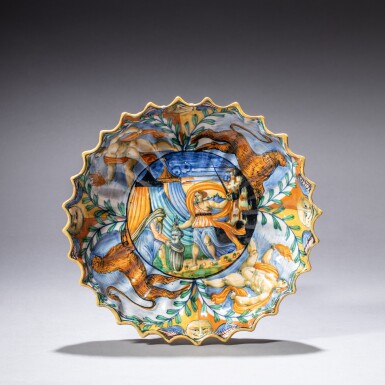
WORKSHOP OF LODOVICO AND ANGELO PICCHI, PERHAPS PAINTED BY ANDREA DA NEGROPONTE, ITALIAN, CASTEL DURANTE, CIRCA 1550-1563
A crespina moulded bowl
No reserve
Estimate
6,000 - 8,000 EUR
We may charge or debit your saved payment method subject to the terms set out in our Conditions of Business for Buyers.
Read more.Lot Details
Description
Painted with Judith and Holofernes and with figures and lions, the back decorated in blue. The Sackler inventory number painted in red 82·3·6
Tin-glazed earthenware (maiolica)
24.5cm. diameter, 9⅝in.
Alfred Spero, London;
Cyril Humphris, London;
Arthur M. Sackler Collection;
His sale (Part II) Christie’s New York, 1 June 1994, lot 37;
Rainer Zietz, London, from whom it was acquired in February 2010.
San Francisco, The Fine Arts Museum of San Francisco, Palace of the Legion of Honor, Italian Maiolica from the Arthur M. Sackler Collections, 1986-1988, no. 65.
This mould-made crespina bowl is part of a group of maiolica moulded bowls with similar patterns; the known pieces are listed in Timothy Wilson's The Golden Age of Italian Maiolica Painting. Catalogue of a private collection, Turin 2018, p. 349. A variant of this type includes a border divided into eight panels with arches. The key piece for the attribution of this group is the crespina in the Arezzo Museum signed Andrea da Negroponte (Fuchs op.cit., 1993, no. 217, p.233). This mould-made bowl lacks the foot, as do several of this form of bowls made in the Picchi brothers’ workshop.
The way the glaze has in part covered the junction between food and body indicates that the separation began in the second glaze firing and suggests that the foot on similar bowls was inadequately attached to the body and broke away easily.
LODOVICO AND ANGELO PICCHI WORKSHOP
Lodovico (d.1573) and Angelo (d.1582 or 1583) Picchi’s workshop was one of the most productive in Castel Durante. Their business was flourishing by 1548-1550 when they received a major commission for pharmacy jars from a Palermo-based Genoese merchant Nicola Canizia. In 1562 the brothers received another order from Palermo, this time from a merchant named Andrea Boerio (of this latter service one jar dated 1562, two others 1563, and two marked as made in the workshop of M° Ludovico Pichio in Castel Durante are known, as well as numerous unmarked jars with the same arms). The Boerio commission proved to be fateful for the Picchi brothers; they were taken to court for failing to deliver the service in time, forcing them into financial trouble. They moved to Rome and formed partnerships with various fellow Durantine painters.
ANDREA DA NEGROPONTE
The pottery-painter identified by Johanna Lessmann as Andrea da Negroponte was one of the most prolific painters of istoriato wares in Castel Durante in the 1550s and 1560s. He can be tentatively considered the main painter of the Boerio series of jars (1562, 1563) and was probably active principally in the workshop of the Picchi brothers. His work is characterised by a mannerist quality and shows a quick use of the brush for an impressionistic effect.
There is a mould-made bowl in the Museum of Arezzo (Fuchs, op.cit. 1993, no.217) that appears to be by the same hand, which bears the name Andrea da Negroponte.
Although the name of Andrea da Negroponte has not been found in Castel Durante documents, John Mallet suggests, following Lessmann, the idea that Da Negroponte was a painter rather than an intended client or a collector, a retailer or a workshop owner. This is reinforced by the existence of a plate in the Barilla sale (Sotheby’s London, 24 March 2012, lot 16) painted with the The Sacrifice of Marcus Curtius and marked on the reverse “A.B.”, which may be the initials of the painter called Andrea, a surname or a nickname. Da Negroponte, meaning in Italian "From the Greek island of Euboea,” may be the name of a painter who immigrated from Greece.
RELATED LITERATURE
T. Wilson, The Golden Age of Italian Maiolica Painting. Catalogue of a private collection, Turin 2018, nos 152, 153, pp. 349-351;
D. Thornton and T. Wilson, Italian Renaissance Ceramics: a catalogue of the British Museum Collection, London 2009, Vol I, p.391;
C. D. Fuchs, Maioliche istoriate rinascimentali del Museo Statale d'Arte Medioevale e Moderna di Arezzo, Arezzo, 1993, no. 217, p.233.
You May Also Like










